A Seismological and Geophysical Database of Kos Island: 10 Years of Digital Records
Abstract
:1. Introduction
2. Dataset and Data Processing
- the data belong to the area of the Eastern part of Greece,
- the time window is defined for the time period 2010–2020,
- shallow mainshocks and a rich aftershock sequence,
- according to the study [39], aftershocks initially occur during the first days in the same region where the mainshock occurs, and then can be expanded in a larger area.
3. Statistical Analysis
4. Discussions and Conclusions
- The maximum number of seismological recordings was observed in 2017 (Nr = 536) and specifically after the earthquake that happened on 20 July 2017, ML 6.2.
- The vast majority of earthquakes are comprised between magnitudes 2.0 ≤ ΜL <3.0 (Nr = 641) and 2.0 ≤ ΜL < 4.0 (Nr = 1132).
- The distribution of magnitudes depending on the depth of the earthquakes ranges was between 5 and 40 km. In 306 events, with a magnitude between 1.0 ≤ ML < 3.0, the depth was calculated between 10 and 20 km, while for several events, Nr = 336, whose magnitude was determined between 3.0 ≤ ΜL < 4.0, the depth was calculated between 10 and 30 km.
- There were a total of 1130 earthquakes estimated with maximum hypocentral distances of 50 km from Kos Island.
- From 2011 to 2016, the distances of earthquakes concerning the middle of Kos ranged between 10 and 30 km; then there was a shift of the epicenters, mainly in 2017, due to the strong earthquake, while, from 2018 and then in the following years, there was a shift again to the initial distances.
- For the year 2010, there were only 91 earthquakes with magnitudes ML ≥ 2.7 in contrast to the following years in which there was an increase in both the number of earthquakes and the density of magnitudes. This can be justified by the increase in stations in the network.
- The error depth for shallow events was ~1 km, while for depth events the error varied between 1 km < depth < 3 km. The depth error depends on various factors such as the software used, the velocity model, the number of the available stations, the azimuth distribution of the existing stations, and the ability of the analyst, etc.
- From 2010 onwards, there was a gradual lower distance of the epicenters from the island of Kos. More specifically, in 2010, the epicentral distances were at 100 km, while in 2017, the earthquake (ML 6.2) was observed with epicenters up to 45 km. This partially confirms the study [52] regarding the Mogi [53] doughnut but needs further analysis to confirm this.
- The magnitude of completeness (Mc) in a database, such as that considered for the Eastern Aegean region, is generally much higher than in other areas (e.g., the Corinthian Gulf). This is mainly due to the large extent of the sparse coverage of the stations. It is essential to understand that we may not detect so many small earthquakes due to a lack of equipment instead of earthquakes.
5. Data and Resources
Funding
Institutional Review Board Statement
Informed Consent Statement
Data Availability Statement
Acknowledgments
Conflicts of Interest
References
- Kiratzi, A.A. Rates of crustal deformation in the North Aegean Trough-North Anatolian fault deduced from seismicity. Pure Appl. Geophys. PAGEOPH 1991, 136, 421–432. [Google Scholar] [CrossRef]
- Jackson, J.; McKenzie, D. The relationship between plate motions and seismic moment tensors, and the rates of active deformation in the Mediterranean and Middle East. Geophys. J. Int. 1988, 93, 45–73. [Google Scholar] [CrossRef] [Green Version]
- Hatzfeld, D.; Ziazia, M.; Kementzetzidou, D.; Hatzidimitriou, P.; Panagiotopoulos, D.; Makropoulos, K.; Papadimitriou, P.; Deschamps, A. Microseismicity and focal mechanisms at the western termination of the North Anatolian Fault and their implications for continental tectonics. Geophys. J. Int. 1999, 137, 891–908. [Google Scholar] [CrossRef]
- Taymaz, T.; Jackson, J.; McKenzie, D. Active tectonics of the north and central Aegean Sea. Geophys. J. Int. 1991, 106, 433–490. [Google Scholar] [CrossRef]
- Lybéris, N. Tectonic evolution of the North Aegean trough. Geol. Soc. Lond. Special Publ. 1984, 17, 709–725. [Google Scholar] [CrossRef]
- Mayer-Rosa, D. Towards uniform earthquake hazzard assessment in Europe. Ann. Geophys. 1993, 36. [Google Scholar] [CrossRef]
- Bourova, E.; Kassaras, I.; Pedersen, H.; Yanovskaya, T.; Hatzfeld, D.; Kiratzi, A. Constraints on absoluteSvelocities beneath the Aegean Sea from surface wave analysis. Geophys. J. Int. 2005, 160, 1006–1019. [Google Scholar] [CrossRef] [Green Version]
- Papazachos, B.C.; Papadimitriou, E.E.; Kiratzi, A.A.; Papaioannou, C.A.; Karakaisis, G.F. Probabilities of occurrence of large earthquakes in the Aegean and surrounding area during the period 1986–2006. Pure Appl. Geophys. PAGEOPH 1987, 125, 597–612. [Google Scholar] [CrossRef]
- Anderson, H.; Jackson, J. Active tectonics of the Adriatic Region. Geophys. J. Int. 1987, 91, 937–983. [Google Scholar] [CrossRef]
- Available online: https://www.researchgate.net/publication/288031207_Sismotectonique_du_Fosse_Nord_Egeen_Relations_avec_la_faille_Nord-Anatolienne (accessed on 4 November 2021).
- McKenzie, D. Active Tectonics of the Mediterranean Region. Geophys. J. Int. 1972, 30, 109–185. [Google Scholar] [CrossRef] [Green Version]
- Galanopoulos, A.G. A Catalogue of Shocks with Io ≥ VI or M ≥ 5 for the Years 1801–1958; Seismological Laboratory, Athens University: Athens, Greece, 1960. [Google Scholar]
- Papadopoulos, G.; Kuran, U.; Takahashi, T.; Minoura, K.; Imamura, F.; Yalçiner, A.; Fokaefs, A. Geological evidence of tsunamis and earthquakes at the Eastern Hellenic Arc: Correlation with historical seismicity in the eastern Mediterranean Sea. Res. Geophys. 2012, 2, e12. [Google Scholar] [CrossRef]
- Papadopoulos, G.A.; Gràcia, E.; Urgeles, R.; Sallares, V.; Marco De Martini, P.; Pantosti, D.; González, M.; Ahmet, C.; Yalciner, C.A.; Mascle, J.; et al. Historical and Pre-Historical Tsunamis in the Mediterranean and Its Connected Seas: Geological Signatures, Generation Mechanisms and Coastal Impacts; Elsevier: Amsterdam, The Netherlands, 2014. [Google Scholar]
- Bocchini, G.M.; Brüstle, A.; Becker, D.; Ruscic, M.; Rische, M.; Papadopoulos, G.A.; Meier, T.M. Slab Segmentation in the South-Eastern Aegean: Evidence from Seismicity; AGU: Washington, DC, USA, 2016. [Google Scholar]
- Ambraseys, N.N.; Finkel, C.F. The Seismicity of Turkey and Adjacent Areas; Eren Ltd.: Istanbul, Turkey, 1995; p. 240. [Google Scholar]
- Kuran, U.; Yalçiner, A.C. Crack Propagations, Earthquakes and Tsunamis in the Vicinity of Anatolia. In Landslides in Sensitive Clays; Springer: Berlin/Heidelberg, Germany, 1993; pp. 159–175. [Google Scholar]
- Minoura, K.; Imamura, F.; Kuran, U.; Nakamura, T.; Papadopoulos, G.A.; Takahasi, T.; Yalciner, A.C. Discovery of Minoan tsunami deposits. Geology 2000, 28, 59–62. [Google Scholar] [CrossRef] [Green Version]
- Ambraseys, N.; Synolakis, C. Tsunami Catalogs for the Eastern Mediterranean, Revisited. J. Earthq. Eng. 2010, 14, 309–330. [Google Scholar] [CrossRef]
- Moshou, A.; Konstantaras, A.; Argyrakis, P. The Major (Mw = 7.0) Earthquake of 30th October 2020 North Samos Island, Greece: Analysis of Seismological and Geodetic Data; EGU General Assembly: Munich, Germany, 2021. [Google Scholar] [CrossRef]
- Desio, A. Le Isole Italiane dell’ Egeo: Studi geologici e geografico-fisici. Geogr. J. 1932, 80, 341. [Google Scholar] [CrossRef]
- Angelier, J.; Cantagrel, J.; Vilminot, J. Neotectonique cassante et volcanisme plio-quaternaire dans l’arc egeen interne; l’ile de Milos (Grece). Bull. De La Société Géologique De Fr. 1977, S7-XIX, 119–124. [Google Scholar] [CrossRef]
- Besenecker, H.; Otte, O. Late Cenozoic development of Kos, Aegean Sea. In Alps, Apennines, Hellenides; Closs, H., Ed.; Pascal Press: Paris, France, 1978; pp. 506–509. [Google Scholar]
- Triantaphyllis, M. Geological Map of Greece. Western Kos Sheet (Kefalos) 1:50.000; IGME: Athens, Greece, 1994. [Google Scholar]
- Makropoulos, K.; Kaviris, G.; Kouskouna, V. An updated and extended earthquake catalogue for Greece and adjacent areas since 1900. Nat. Hazards Earth Syst. Sci. 2012, 12, 1425–1430. [Google Scholar] [CrossRef] [Green Version]
- Kouskouna, V.; Sesetyan, K.; Stucchi, M. The Kos Earthquake of 1933: A Preliminary Study; Gruppo Nazionale di Geofisica della Terra Solida 36o Convegno Nazional: Trieste, Italy, 2017. [Google Scholar]
- Ambraseys, N.N. Reassessment of earthquakes, 1900–1999, in the Eastern Mediterranean and the Middle East. Geophys. J. Int. 2001, 145, 471–485. [Google Scholar] [CrossRef] [Green Version]
- Tibaldi, A. Contractional tectonics and magma paths in volcanoes. J. Volcanol. Geotherm. Res. 2008, 176, 291–301. [Google Scholar] [CrossRef]
- Nomikou, P.; Papanikolaou, D. Extension of active fault zones on Nisyros volcano across the Yali-Nisyros Channel based on onshore and offshore data. Mar. Geophys. Res. 2011, 32, 181–192. [Google Scholar] [CrossRef]
- Nomikou, P.; Papanikolaou, D.; Alexandri, M.; Sakellariou, D.; Rousakis, G. Submarine volcanoes along the Aegean volcanic arc. Tectonophysics 2013, 597, 123–146. [Google Scholar] [CrossRef]
- Uluğ, A.; Duman, M.; Ersoy, Ş.; Özel, E.; Avcı, M. Late Quaternary sea-level change, sedimentation and neotectonics of the Gulf of Gökova: Southeastern Aegean Sea. Mar. Geol. 2005, 221, 381–395. [Google Scholar] [CrossRef]
- Tur, H.; Yaltirak, C.; Kerim, I.E.; Sarikavak, T. Pliocene—Quaternary tectonic evolution of the Gulf of Gökova, southwest Turkey. Tectonophysics 2015, 638, 158–176. [Google Scholar] [CrossRef]
- Ocakoğlu, N.; Nomikou, P.; Işcan, Y.; Loreto, M.F.; Lampridou, D. Evidence of extensional and strike-slip deformation in the offshore Gökova-Kos area affected by the July 2017 Mw6.6 Bodrum-Kos earthquake, eastern Aegean Sea. Geo-Mar. Lett. 2018, 38, 211–225. [Google Scholar] [CrossRef]
- Shebalin, N.V.; Karnik, V.; Hadzievski, D. UNDP-Unesco Survey of the Seismicity of Balkan Region. Catalogue of Earthquakes, Part I, 1901–1970, Skopje. References-Scientific Research Publishing. Scirp.org. 1974. Available online: https://scirp.org/(S(lz5mqp453edsnp55rrgjct55))/reference/referencespapers.aspx?referenceid=2976457 (accessed on 4 November 2021).
- Makropoulos, K.; Burton, P.W. A catalogue of seismicity in Greece and adjacent areas. Geophys. J. Int. 1981, 65, 741–762. [Google Scholar] [CrossRef] [Green Version]
- Makropoulos, K.; Drakopoulos, J.K.; Latousakis, J.B. A revised and extended earthquake catalogue for Greece since 1900. Geophys. J. Int. 1989, 98, 391–394. [Google Scholar] [CrossRef] [Green Version]
- Papazachos, B.C.; Comninakis, P.E. A catalogue of earthquakes in Greece and the surrounding area for the period 1901–1980. Publ. Univ. Thessalon. Geophys. Lab. 1982, 5, 146. [Google Scholar]
- Papazachos, B.C.; Papazachou, C.C. The Earthquakes of Greece; Ziti: Thessaloniki, Greece, 1989; p. 356. [Google Scholar]
- Papazachos, B.; Papazachou, C. The Earthquakes of Greece; Ziti: Thessaloniki, Greece, 1997; p. 304. [Google Scholar]
- NOA Seismic Network (HL)—Introduction. 2021. Available online: https://bbnet.gein.noa.gr/HL (accessed on 4 November 2021).
- Department of Geophysics—Geothermics. 2021. Available online: http://www.geophysics.geol.uoa.gr (accessed on 4 November 2021).
- Τομέας Γεωφυσικής A.Π.Θ. 2021. Available online: http://geophysics.geo.auth.gr (accessed on 4 November 2021).
- UPSL—Uni. Patras Seismological Laboratory. 2021. Available online: http://seismo.geology.upatras.gr (accessed on 4 November 2021).
- Scolv—SeisComP3 Seattle Documentation. 2021. Available online: https://www.seiscomp.de/seiscomp3/doc/seattle/current/apps/scolv.html (accessed on 4 November 2021).
- Hellenic Strong Motion Network. Available online: https://accelnet.gein.noa.gr (accessed on 19 July 2021).
- Styron, R.; Pagani, M. The GEM Global Active Faults Database. Earthq. Spectra 2020, 36, 160–180. [Google Scholar] [CrossRef]
- EU-DEM. 2021. Available online: https://land.copernicus.eu/imagery-in-situ/eu-dem (accessed on 18 January 2021).
- Ammon, C.J.; Velasco, A.A.; Lay, T.; Wallace, T.C. Foundations of Modern Global Seismology; Elsevier: Amsterdam, The Netherlands, 2021. [Google Scholar]
- Katsumata, A. Comparison of magnitudes estimated by the Japan Meteorological Agency with moment magnitudes for intermediate and deep earthquakes. Bull. Seism. Soc. Am. 1996, 86, 832–842. [Google Scholar] [CrossRef]
- Richter, C.F. An instrumental earthquake magnitude scale. Bull. Seism. Soc. Am. 1935, 25, 1–32. [Google Scholar] [CrossRef]
- Ganas, A.; Roumelioti, Z.; Karastathis, V.; Chousianitis, K.; Moshou, A.; Mouzakiotis, E. Erratum to: The Lemnos 8 January 2013 (M w = 5.7) earthquake: Fault slip, aftershock properties and static stress transfer modeling in the north Aegean Sea. J. Seism. 2015, 19, 273. [Google Scholar] [CrossRef] [Green Version]
- Ganas, A.; Kourkouli, P.; Briole, P.; Moshou, A.; Elias, P.; Parcharidis, I. Coseismic Displacements from Moderate-Size Earthquakes Mapped by Sentinel-1 Differential Interferometry: The Case of February 2017 Gulpinar Earthquake Sequence (Biga Peninsula, Turkey). Remote Sens. 2018, 10, 1089. [Google Scholar] [CrossRef] [Green Version]
- Mogi, K. Some features of recent seismic activity in and around Japan, 2, Activity before and after great earthquakes. Bull. Earthq. Res. Inst. 1969, 47, 395–417. [Google Scholar]
- BBNET—Hellenic Unified Seismic Network (HUSN). 2021. Available online: https://bbnet.gein.noa.gr/HL/real-time-plotting/husn/husnmap (accessed on 4 November 2021).
- ORFEUS Data Center WebDC3 Web Interface. 2021. Available online: http://orfeus-eu.org/webdc3/ (accessed on 4 November 2021).
- ORFEUS—Strong Motion Data. 2021. Available online: http://orfeus-eu.org/data/strong/ (accessed on 4 November 2021).
- Available online: http://www.orfeus-eu.org/eida (accessed on 4 November 2021).
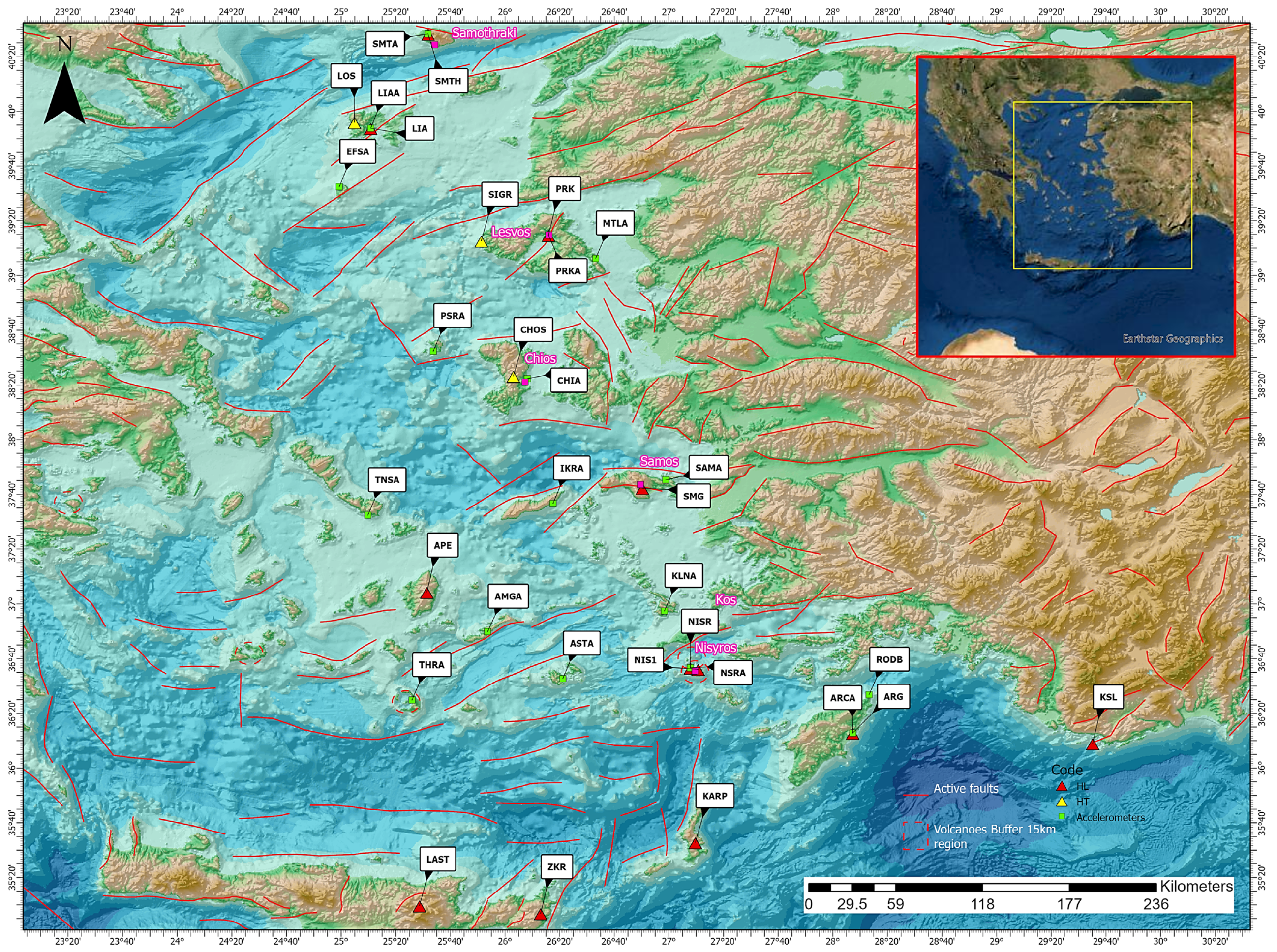
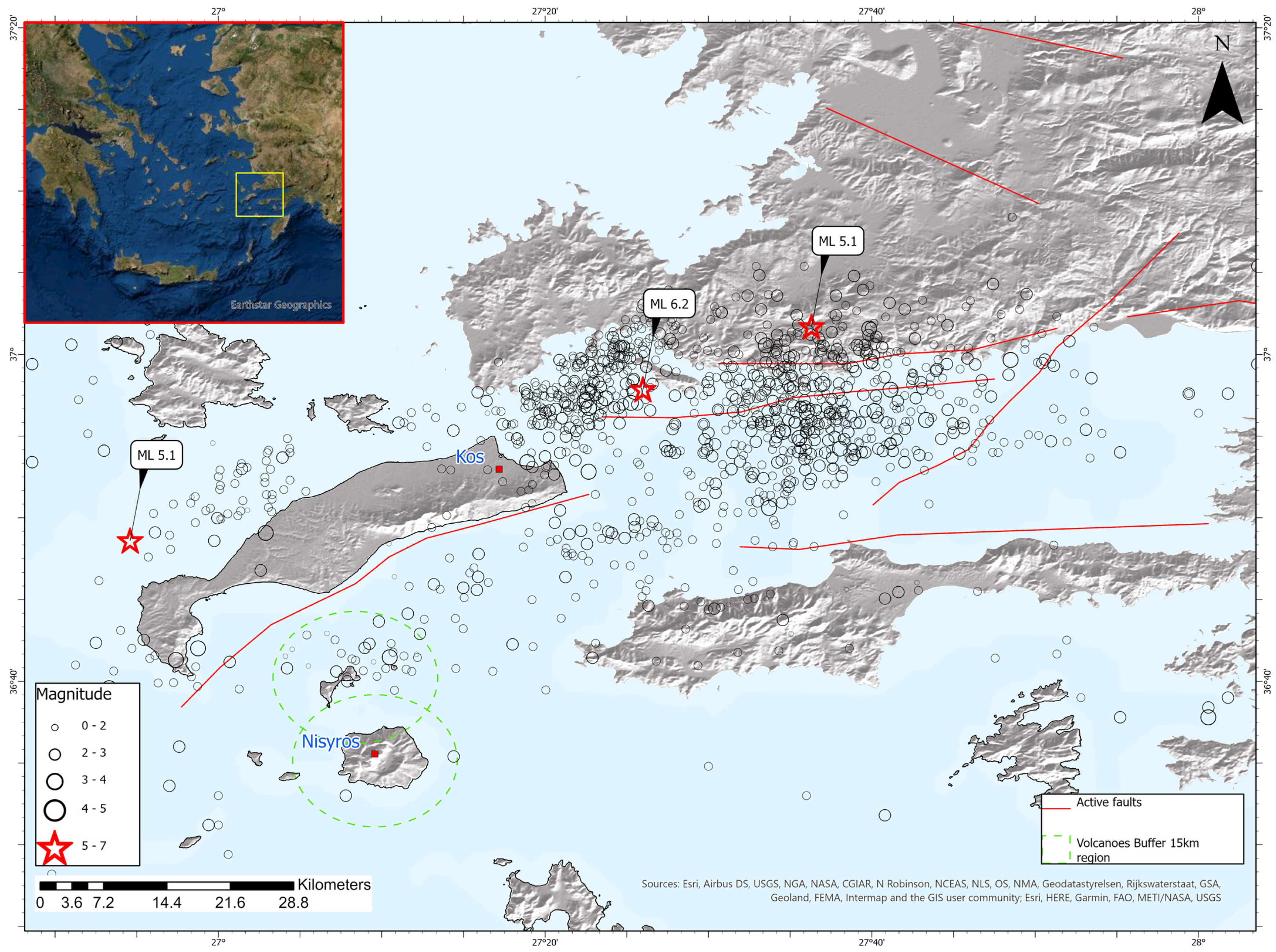
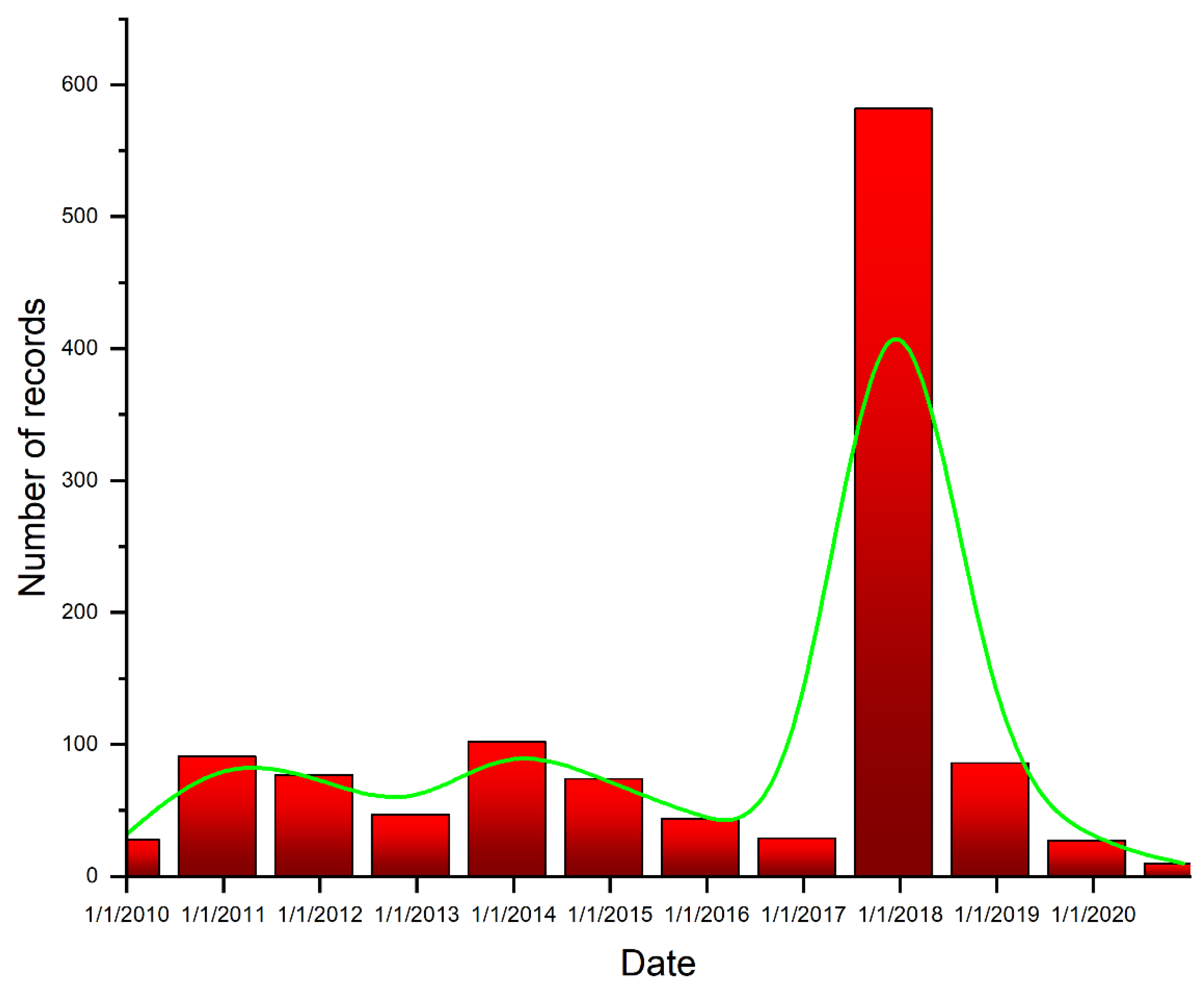
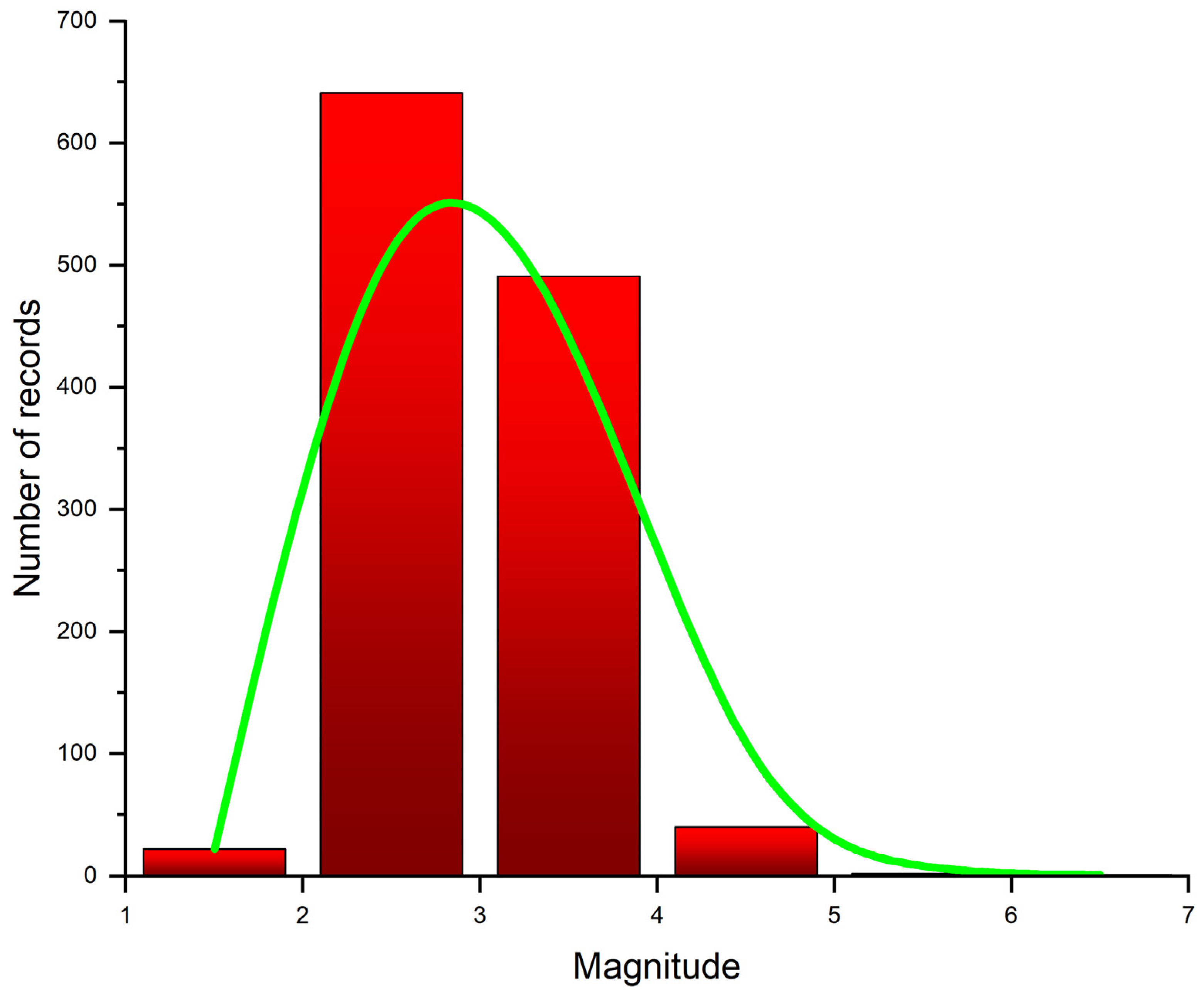
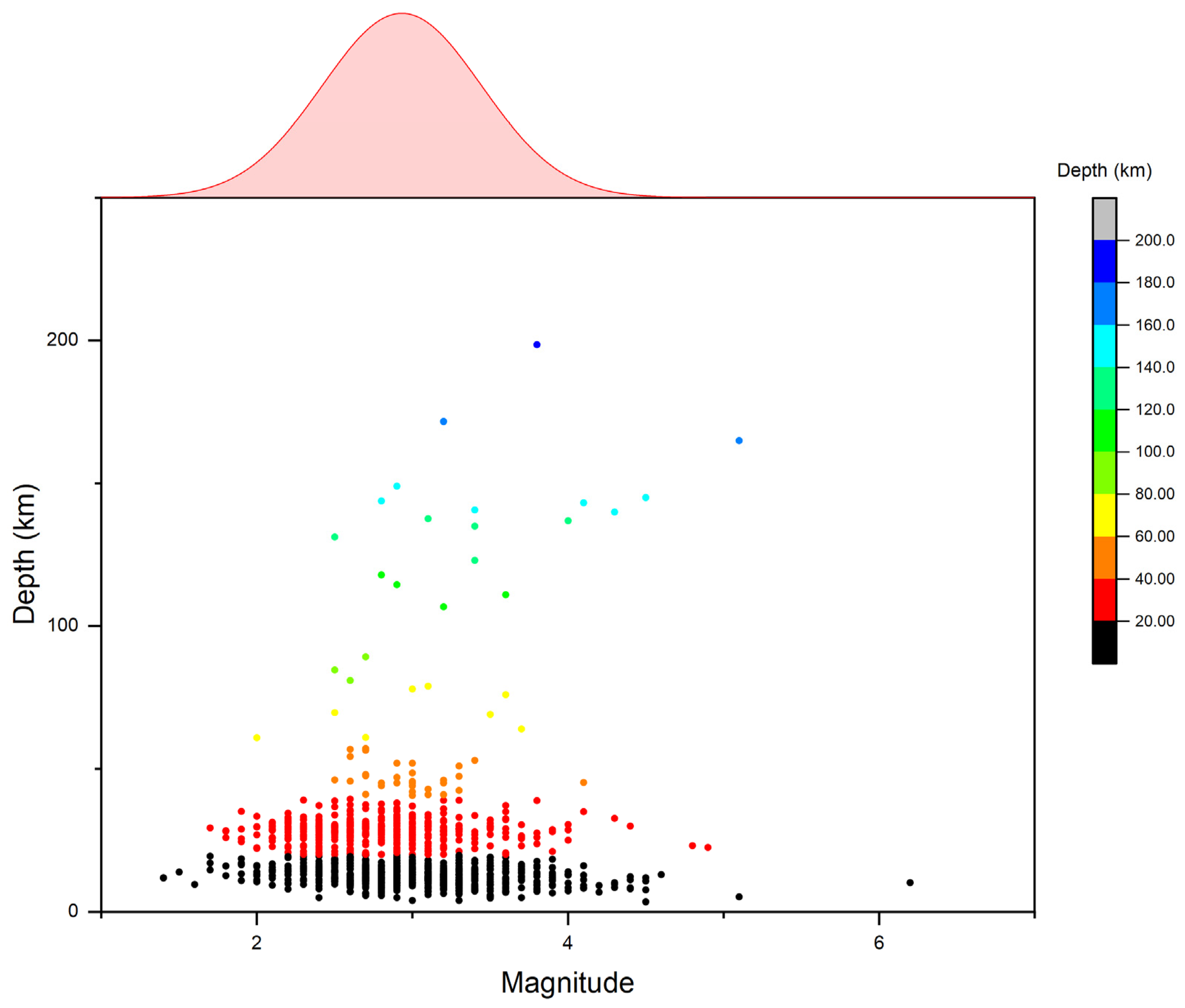
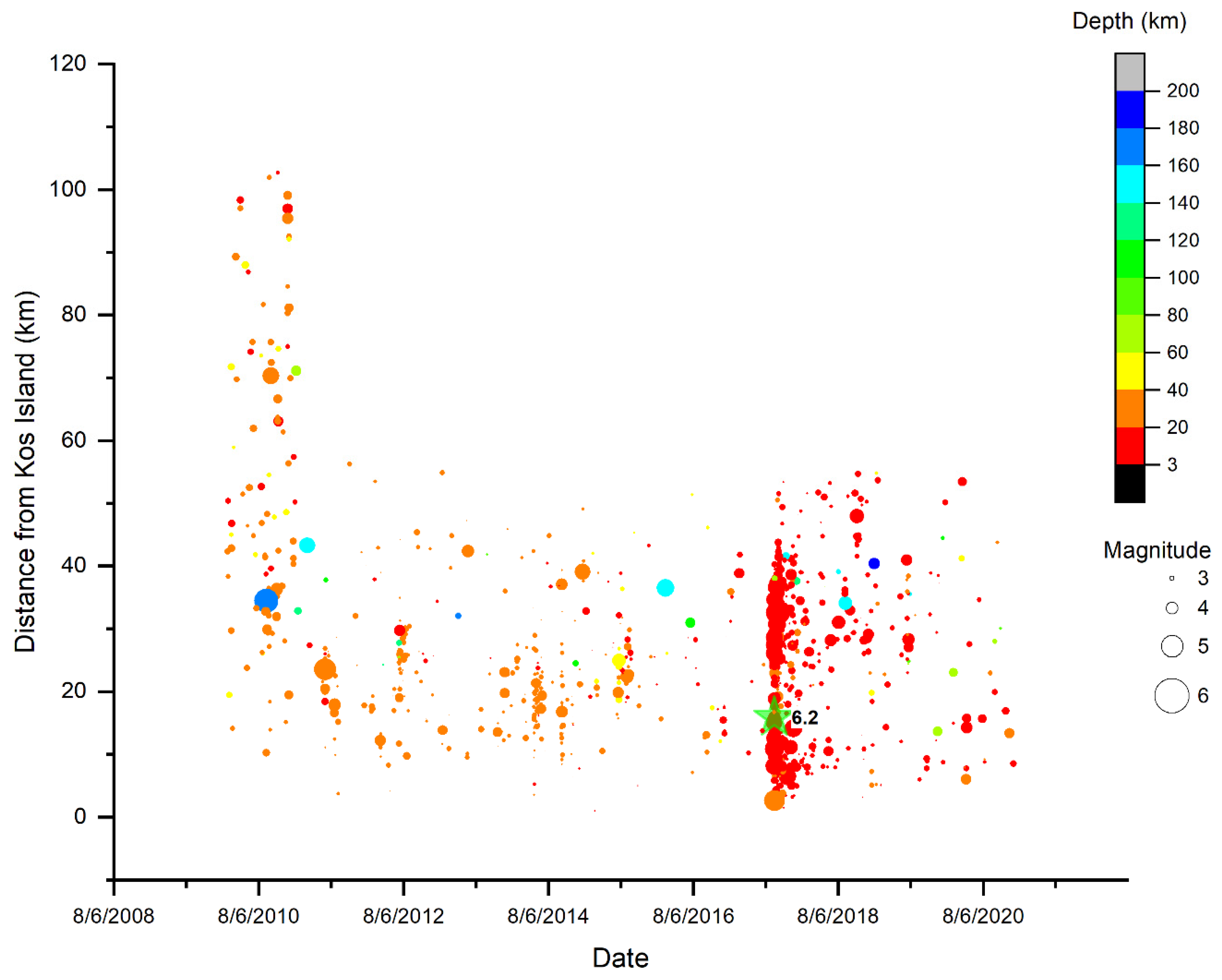

| Stations | Latitude (°) | Longitude (°) | Elevation (m) | Datalogger | Seismometer |
|---|---|---|---|---|---|
| APE | 37.0727 | 25.523 | 608 | PS6-SC | STS-2 |
| ARG | 36.2135 | 28.1212 | 148 | DR24-SC | LE-3D/20 |
| KARP | 35.5471 | 27.161 | 524 | PS6-SC | EpiSensor FBA ES-T |
| KSL | 36.1503 | 29.5856 | 64 | PS6-SC | CMG-3ESPC/60 |
| LAST | 35.162 | 25.478 | 870 | PS6-SC | CMG-40T/30 |
| LIA | 39.8972 | 25.1805 | 67 | PS6-SC | CMG-5TD |
| NISR | 36.6106 | 27.1309 | 48 | PS6-SC | CMG-40T/30 |
| PRK | 39.2456 | 26.2649 | 130 | EDR-209 | STS-2 |
| SMG | 37.7042 | 26.8377 | 348 | DR24-SC | Trillium 120P |
| SMTH | 40.4709 | 25.5305 | 365 | PS6-SC | CMG-3ESPC/60 |
| ZKR | 35.1147 | 26.217 | 270 | PS6-SC | STS-2 |
| CHOS | 38.3868 | 26.0506 | 854 | CENTAUR | T3P23 |
| SIGR | 39.2114 | 25.8553 | 92 | Τ35012 | CMG-3ESP/100sec |
| LOS | 39.933 | 25.0810° | 460 | S-13 | TRIDENT |
| NIS1 | 36.6023 | 27.1782 | 378 | T35362 | CMG-3ESP/100 |
| Stations | Latitude (°) | Longitude (°) | Elevation (m) | Sensor |
|---|---|---|---|---|
| SMTA | 40.4709 | 25.5304 | 360 | CMG-5TDE |
| LIAA | 39.8972 | 25.1805 | 58 | CMG-5TDE |
| PRKA | 39.2456 | 26.2651 | 120 | CMG-5TDE |
| MTLA | 39.1042 | 26.5532 | 12 | QDR |
| PSRA | 38.5397 | 25.562 | 13 | CMG-5TDE |
| CHIA | 38.3713 | 26.1362 | 8 | QDR |
| SAMA | 37.7537 | 26.9806 | 16 | CMG-5TDE |
| IKRA | 37.6111 | 26.2928 | 30 | CMG-5TDE |
| TNSA | 37.5394 | 25.1631 | 21 | CMG-5TDE |
| AMGA | 36.8315 | 25.8938 | 300 | CMG-5TDE |
| KLNA | 36.957 | 26.9727 | 35 | CMG-5TDE |
| NSRA | 36.6106 | 27.1309 | 40 | CMG-5TDE |
| ASTA | 36.5454 | 26.3528 | 65 | CMG-5TDE |
| THRA | 36.415 | 25.4324 | 220 | CMG-5TDE |
| RODB | 36.4471 | 28.2211 | 26 | CMG-5TDE |
| ARCA | 36.2135 | 28.1214 | 177 | QDR |
| EFSA | 39.5401 | 24.9886 | 5 | CMG-5TDE |
| Magnitude ML | Depth (km) | |||||
|---|---|---|---|---|---|---|
| d ≤ 10 | 10 < d ≤ 20 | 20 < d ≤ 30 | 30 < d ≤ 50 | 50 < d ≤ 70 | d > 70 | |
| Total | 156 (13.02%) | 563 (46.99%) | 291 (24.29%) | 151 (12.60%) | 13 (1.08%) | 24 (2.0%) |
| 1.0 ≤ M < 2.0 | 1 (0.0008%) | 13 (1.08%) | 7 (0.58%) | 1 (0.0008%) | 0 | 0 |
| 2.0 ≤ M < 3.0 | 51 (4.25%) | 293 (24.45%) | 186 (15.52%) | 96 (8.01%) | 8 (0.66%) | 8 (0.66%) |
| 3.0 ≤ M < 4.0 | 89 (7.42%) | 243 (20.28%) | 93 (7.76%) | 50 (4.17%) | 5 (0.41%) | 11 (0.91%) |
| 4.0 ≤ M < 5.0 | 14 (1.16%) | 13 (1.08%) | 5 (0.41%) | 4 (0.33%) | 0 | 4 (0.33%) |
| 5.0 ≤ M < 6.0 | 1 (0.0008%) | 0 | 0 | 0 | 0 | 1 (0.0008) |
| 6.0 ≤ M < 7.0 | 0 | 1 (0.0008%) | 0 | 0 | 0 | 0 |
Publisher’s Note: MDPI stays neutral with regard to jurisdictional claims in published maps and institutional affiliations. |
© 2021 by the author. Licensee MDPI, Basel, Switzerland. This article is an open access article distributed under the terms and conditions of the Creative Commons Attribution (CC BY) license (https://creativecommons.org/licenses/by/4.0/).
Share and Cite
Moshou, A. A Seismological and Geophysical Database of Kos Island: 10 Years of Digital Records. Earth 2021, 2, 920-932. https://doi.org/10.3390/earth2040053
Moshou A. A Seismological and Geophysical Database of Kos Island: 10 Years of Digital Records. Earth. 2021; 2(4):920-932. https://doi.org/10.3390/earth2040053
Chicago/Turabian StyleMoshou, Alexandra. 2021. "A Seismological and Geophysical Database of Kos Island: 10 Years of Digital Records" Earth 2, no. 4: 920-932. https://doi.org/10.3390/earth2040053
APA StyleMoshou, A. (2021). A Seismological and Geophysical Database of Kos Island: 10 Years of Digital Records. Earth, 2(4), 920-932. https://doi.org/10.3390/earth2040053






